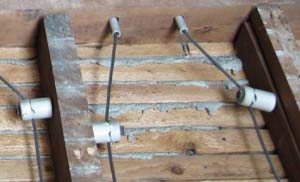Knob and Tube Wiring
Homes in the U.S. built from around 1880 to the 1940s often still have knob and tube electrical wiring. This is where electrical wires anchored by ceramic insulating knobs pass through tubes placed inside holes drilled in the joists of the house. It’s important for home buyers to understand that knob and tube wiring itself is not unsafe. In fact, the necessary drilling, soldering, wrapping, and splicing during the original installation required great deal of skill, since the wiring was meant to last. However, home buyers may have a problem getting insurance for a home with knob and tube wiring.

When you are buying a home with knob and tube wiring, there are a few issues to be aware of. For instance, insulation cannot touch the wires, as the heat from the wires cannot dissipate. Knob and tube wiring also does not provide a third wire for grounding. Even if two-slot outlets are replaced with three prong outlets (for devices that require them, such as kitchen appliances) there is still no third wire which protects against electric shock. One of the most common issues with knob and tube wiring is with incorrect modifications. Because it is easily accessible, some homeowners make their own repairs and do not splice the wire correctly or they make inadequate, unsafe modifications. Always hire a licensed electrician to make changes or updates to knob and tube wiring.
Knob and tube wiring is no longer used in homes because it doesn’t carry the same capacity for electricity that modern homes require. Modern households tend to use much higher loads of electricity than the wiring was originally designed for (usually 60 amps). Homeowners should not install higher amp fuses to match the increase in electricity use as this will cause the wires to overheat. Consider the age of knob-and-tube wiring. The wiring was intended initially for operating lightbulbs. Look at all the electrical appliances that fill our houses these days. A/C condensers, flat-screen TV's, hair dryers, etc. Even if the rubberized insulation around the wiring hasn't been chewed by rodents, trying to run a hair dryer or a front-loading washer on such antique wiring is playing with fire — literally, since an electrical overload is very likely.